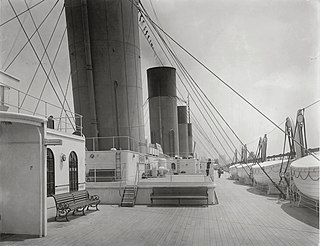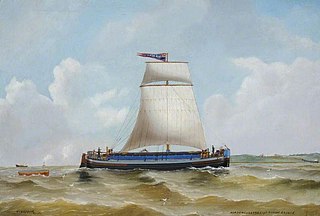
A boat is a watercraft of a large range of types and sizes, but generally smaller than a ship, which is distinguished by its larger size, shape, cargo or passenger capacity, or its ability to carry boats.

A ship is a large vessel that travels the world's oceans and other navigable waterways, carrying cargo or passengers, or in support of specialized missions, such as defense, research and fishing. Ships are generally distinguished from boats, based on size, shape, load capacity and purpose. Ships have supported exploration, trade, warfare, migration, colonization, and science. Ship transport is responsible for the largest portion of world commerce.

Naval architecture, or naval engineering, is an engineering discipline incorporating elements of mechanical, electrical, electronic, software and safety engineering as applied to the engineering design process, shipbuilding, maintenance, and operation of marine vessels and structures. Naval architecture involves basic and applied research, design, development, design evaluation (classification) and calculations during all stages of the life of a marine vehicle. Preliminary design of the vessel, its detailed design, construction, trials, operation and maintenance, launching and dry-docking are the main activities involved. Ship design calculations are also required for ships being modified. Naval architecture also involves formulation of safety regulations and damage-control rules and the approval and certification of ship designs to meet statutory and non-statutory requirements.

The keel is the bottom-most longitudinal structural element on a watercraft. On some sailboats, it may have a hydrodynamic and counterbalancing purpose, as well. The laying of the keel is often the initial step in the construction of a ship. In the British and American shipbuilding traditions, this event marks the beginning date of a ship's construction.

In a military navy, a rate or rating, and sometimes known as a bluejacket in the United States, is a junior enlisted sailor who is below the military rank of warrant officer. They are not a commissioned officer. Depending on the country and navy that uses it, the exact term and the range of ranks that it refers to may vary.

Boat building is the design and construction of boats and their systems. This includes at a minimum a hull, with propulsion, mechanical, navigation, safety and other systems as a craft requires.

Operation Market Time was the United States Navy, Republic of Vietnam Navy and Royal Australian Navy operation begun in 1965 to stop the flow of troops, war material, and supplies by sea, coast, and rivers, from North Vietnam into parts of South Vietnam during the Vietnam War. Also participating in Operation Market Time were United States Coast Guard's Squadron One and Squadron Three. The U.S. Coast Guard operated, under U.S. Navy command, heavily armed 82-foot (25 m) patrol boats and large cutters armed with 5-inch naval guns, which were used in battle and gunfire support.

USS Essex was an Enterprise-class wooden-hulled armed naval steam sloop of war. She was built between 1874 and 1876 by Donald McKay at the Kitter Naval Yard of East Boston, Massachusetts. She was commissioned on 3 October 1876 by the United States Navy. On 23 December 1930 Essex was sold for scrap, and on 14 October 1931 she was taken to the beach just outside Duluth Harbor where they set fire to her; she eventually burned to the waterline. On 14 April 1994 the remains of Essex were listed on the National Register of Historic Places. Her partially surviving hulk is significant because she is the only known remnant of the work of master shipbuilder McKay.

A deck is a permanent covering over a compartment or a hull of a ship. On a boat or ship, the primary or upper deck is the horizontal structure that forms the "roof" of the hull, strengthening it and serving as the primary working surface. Vessels often have more than one level both within the hull and in the superstructure above the primary deck, similar to the floors of a multi-storey building, that are also referred to as decks, as are certain compartments and decks built over specific areas of the superstructure. Decks for some purposes have specific names.
This glossary of nautical terms is an alphabetical listing of terms and expressions connected with ships, shipping, seamanship and navigation on water. Some remain current, while many date from the 17th to 19th centuries. The word nautical derives from the Latin nauticus, from Greek nautikos, from nautēs: "sailor", from naus: "ship".

A billet is a living-quarters to which a soldier is assigned to sleep. Historically, a billet was a private dwelling that was required to accept the soldier.
A master-at-arms may be a naval rating, responsible for law enforcement, regulating duties, security, anti-terrorism/force protection (AT/FP) for a country's navy; an army officer responsible for physical training; or a member of the crew of a merchant ship responsible for security and law enforcement. In some navies, a ship's corporal is a position—not the rank—of a petty officer who assists the master-at-arms in his various duties. Historically, a master-at-arms was responsible for the training of soldiers during peace time, or actively involved in leading the defense of a fortification during war time.

USS M-1 (SS-47) was a unique submarine of the United States Navy. Although built as a fully operational boat, M-1 was built with a radically different double-hulled design. This was in marked contrast to Simon Lake's and Electric Boat's single-hulled concepts. Ultimately shown to be unsuccessful, no other submarines of this class were built, although future advances in construction and metallurgy science made the double hull design a standard one for the USN.
The strength of ships is a topic of key interest to naval architects and shipbuilders. Ships which are built too strong are heavy, slow, and cost extra money to build and operate since they weigh more, whilst ships which are built too weakly suffer from minor hull damage and in some extreme cases catastrophic failure and sinking.

An auxiliary ship is a naval ship designed to support combatant ships and other naval operations. Auxiliary ships are not primary combatant vessels, though they may have some limited combat capacity, usually for purposes of self-defense.

The Latécoère 380 was a flying boat aircraft designed and produced by the French aircraft manufacturer Latécoère. It was designed for use on Aéropostale's mail routes to South America, the aircraft subsequently saw military service as a maritime patrol aircraft.

The Humber keel was a type of single-masted, square-rigged sailing craft used for inshore and inland cargo transport around Hull and the Humber Estuary, in the United Kingdom, particularly through the late 19th and early 20th centuries.

The Lexington-class battlecruisers were officially the only class of battlecruiser to ever be ordered by the United States Navy. While these six vessels were requested in 1911 as a reaction to the building by Japan of the Kongō class, the potential use for them in the U.S. Navy came from a series of studies by the Naval War College which stretched over several years and predated the existence of the first battlecruiser, HMS Invincible. The fact they were not approved by Congress at the time of their initial request was due to political, not military considerations.
Longitudinal framing is a method of ship construction in which large, widely spaced transverse frames are used in conjunction with light, closely spaced longitudinal members. This method, Isherwood felt, lent a ship much greater longitudinal strength than in ships built in the traditional method, where a series of closely spaced transverse frames are fitted from the keel to the sheer line, with corresponding deck beams, a method that is well suited to support longitudinal planking.
This glossary of nautical terms is an alphabetical listing of terms and expressions connected with ships, shipping, seamanship and navigation on water. Some remain current, while many date from the 17th to 19th centuries. The word nautical derives from the Latin nauticus, from Greek nautikos, from nautēs: "sailor", from naus: "ship".















